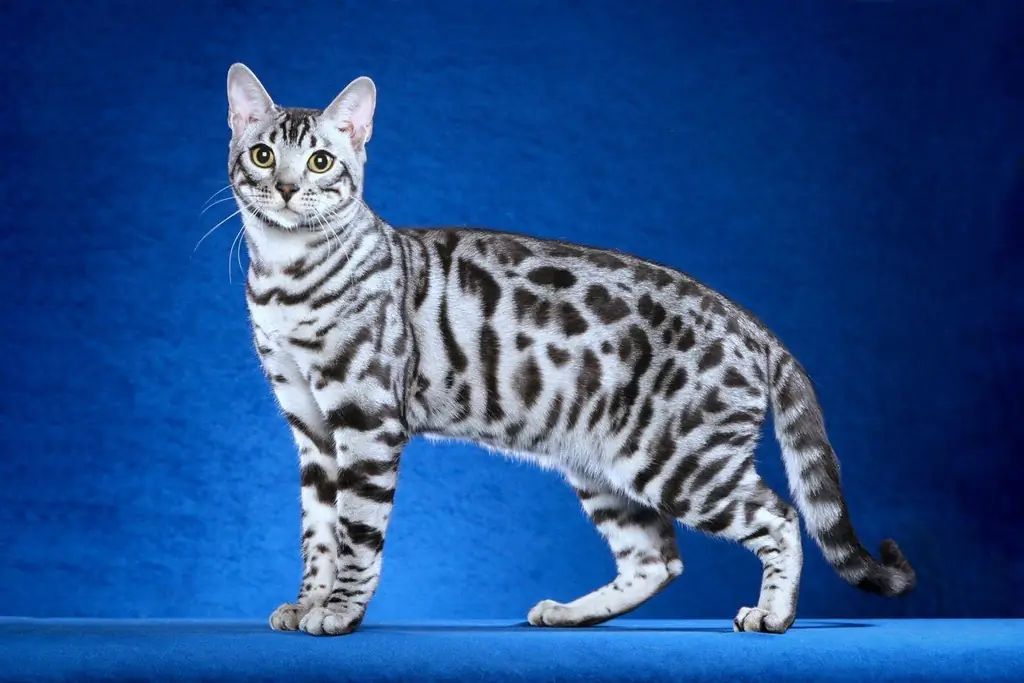
Table of contents:
- Bengal cats - a miracle of breeding
- History of the origin of the breed
- External features of the Bengal cat
- Character traits and behavioral features of the Bengal cat
- What diseases do Bengal cats most often suffer from?
- How to choose a Bengal kitten
- Food
- Toilet and hygiene procedures
- Breeding Bengal cats
- Castration and sterilization
- Reviews of the owners about the breed
- Author Bailey Albertson [email protected].
- Public 2023-12-17 12:53.
- Last modified 2025-01-23 12:41.
Bengal cats - a miracle of breeding

Bengal cats are a young breed. These felines would not have appeared without the help of humans. Thanks to breeding (crossing with different breeds), these beauties have many good qualities.
Content
- 1 History of the origin of the breed
-
2 External features of the Bengal cat
-
2.1 Colors of cats
- 2.1.1 Brown
- 2.1.2 Silver
- 2.1.3 Snowy
- 2.2 Disadvantages of the breed
-
-
3 Traits and behavioral features of the Bengal cat
3.1 Video: useful information about Bengal cats
-
4 What diseases do Bengal cats most often suffer from?
4.1 Prevention
- 5 How to choose a Bengal kitten
- 6 Nutrition
- 7 Toilet and hygiene procedures
- 8 Breeding Bengal cats
- 9 Castration and sterilization
- 10 Owner reviews about the breed
History of the origin of the breed
The first Bengal cat appeared in the middle of the 20th century. Jean Mill became the creator of the breed. She was on business in Bangkok. It was there that the wild Asian leopard cat lived, similar in size to the domestic one. Then these wild animals were practically exterminated by poachers. They were caught because of the expensive skins, and the kittens were sold to tourists at the local market as living souvenirs. Jean decided to buy herself such a baby and bring him to the USA. She named her unusual baby Malaysia.

The wild Asian leopard cat is the progenitor of the Bengal breed
Thanks to this union of two dissimilar representatives of the feline family, an absolutely healthy hybrid cat was born in 1963 with characteristic specks obtained from her mother. They called her Kin-Kin. When Kin-Kin grew up, it was decided to mate with the same black domestic cat, but after some time Kin-Kin died of pneumonia, and breeding stopped.
Only in the 80s did Jean return to the embodiment of her desire to create a new breed. Having asked geneticists at the University of California to help her in this matter, she received 9 hybrid cats as a result of mating Asian leopard cats with domestic cats of various breeds. They became the basis for the future new breed - they were mated with cats of different breeds, mainly Burmese and Egyptian Mau.
The biggest problem was that cats often became infertile during crossbreeding. And another snag was that wild cats did not get along with the domestic ones that they were offered as partners. Often, wild representatives of the feline family killed their domestic partners along with kittens.
In the early 90s of the XX century, the Bengala breed was registered under the name "safari", but then this name was changed to the modern one. After the adoption of the breed standard, Jean Mill participated in the TICA (The International Cat Association) championship with her domestic and completely tame leopard. At the moment, cats of this breed are most common in the United States. To this day, there is a nursery Jane Mill called "Millwood".

The Bengal cat acquired its amazing color from a wild leopard cat
External features of the Bengal cat
An adult Bengal cat is significantly larger than a female. Its weight usually does not exceed 7 kg, but sometimes larger individuals come across. The physique is slim and fit. The body is oblong, with strong and strong muscles. The specific features of the body structure of this breed are elongated hind legs, as if lifting the body. The movements of a Bengal cat are identical to those of a wild animal like a leopard or a tiger. The neat wedge-shaped head looks a little eccentric due to the unusual location of the ears, slightly rounded to the tip, and the slightly "inflated" nose.
Cat colors
The following colors of Bengal cats are recognized:
- brown tabby spotted;
- brown tabby marble;
- seal-sepia-spotted;
- sil-sepia-marble;
- seal-mink-spotted;
- seal-mink-marble;
- seal-links-point-spotted;
- seal-links-point-marble.
Brown
Bengal cats of the standard brown color have a brown-black pattern on a golden coat. The clearer the pattern is, the more upscale the cat is considered. The iris of the eyes in brown color should be green, and the tip of the tail should be black.

A clear pattern on the coat of a Bengal cat is a sign of high class
Silvery
Silver Bengals are much less common. They have a silvery ticked coat, a distinctive black or gray pattern and green eyes. The leopard pattern is more common in Bengals of this color than the marble pattern. Although it is a great success to see them at exhibitions even now.

Silver Bengal cats are very rare
Snowy
Bengal cats of white color are of 3 types:
- Seal Lynx Point kittens are born completely white, while their spots are first reddish-pink, and by about 11-12 months they acquire a brown shade of varying saturation. By the same age, the background acquires cream or beige shades, and marks of weak contrast characteristic of the breed appear on it. Blue eyes.
- Seal-mink tabbies differ only in eye color - they have all shades of green.
- Seal sepia tabbies have more contrasting markings. The overall impression is that they are the darkest of the snowy Bengals. Eyes can be of any shade of yellow and green. A tabby kitten - both minky and sepia - is born with markings.

Snow Bengal cats have very expressive eyes
Disadvantages of the breed
There are a number of signs that are disadvantages and can even lead to the disqualification of an animal at the show. These include:
- lack of a pattern on the stomach;
- merged spots that form vertical stripes;
- the absence of a tail or its visible defects;
- complete blindness or strabismus, etc.
Also, cats with an aggressive character are not allowed to participate in exhibitions. Those pets that clearly show a desire to attack or bite will be disqualified.
Character traits and behavioral features of the Bengal cat
Bengal cats are active and love to play. The period of quiet pastime is periodically replaced by running around the apartment in an attempt to catch up with your toy. These cats love to climb all sorts of hills very much: cabinets, shelves, etc. The mischievous Bengal will not let you get bored, but these cats are not averse to relaxing on the sofa and purring lazily.
Bengal cat is very strongly attached to its owner. He is incredibly loyal and responsive. Representatives of the Bengal breed remain faithful friends for their owners until the end of their lives. To become a friend of a furry pet, he needs to devote a lot of time to communication and play.
From my own experience, I can say that this type of cat quickly finds a common language with dogs and other pets in the house. My friend had a Bengal cat. It so happened that he had to move to another city for a while. And he asked me to shelter his pet. At first I did not want to agree, because at that time I had a dog. But he still managed to convince me. And what was my surprise when, literally a couple of weeks after I received this four-legged miracle, I found myself sleeping practically in the arms of my old dog and this spotted prankster.
Bengal cats are very fond of water. Their favorite pastime is playing with a stream of water from the tap. And they love showers even more. There are even those who gladly accept it together with the owner. Some individuals generally jump into baths filled with water and even swimming pools. Probably, they got such an unusual habit from the Asian leopard cat.
These fluffy beauties are very smart. They are easy to train. For example, they can, like dogs, catch a small toy after a throw. Bengal can even be tamed to a human toilet. They can acquire a large number of new skills simply by looking at the behavior of family members. At one point, they can surprise their owner that they know how to unlock the door, turn on the lights, and much more.

Bengal cats are very agile and love to climb tall objects in the room.
But despite all their advantages, Bengal cats also have some disadvantages. These include the following:
- they love to bite;
- they need to build a secluded place and provide a fairly large area for research;
- they are very active, which is not always pleasant to calm and lazy owners;
- they "talk" a lot.
Video: useful information about Bengal cats
What diseases do Bengal cats most often suffer from?
The average life span of Bengals is 12-15 years. It depends on where you live and how you care for your cat.
Real Bengal cats have a strong body, but they are still susceptible to some diseases. Most often they suffer from the following health problems:
- Food poisoning, indigestion, bowel disease. Bengals have a very sensitive stomach, which reacts poorly to changing feeds and poor quality nutrition. Most often, they suffer from inflammatory bowel disease.
- Hypertrophic kirdiomyopathy. This is a pathology of the structure of the heart, when one of the walls is thicker than the others. The danger of this disease lies in the absence of early symptoms. It often does not manifest itself, therefore, for Bengal cats, regular heart examinations: ultrasound and ECG are important.
- Flat chest syndrome. This Bengal disease is peculiar only to kittens. Due to the violation of the structure of the chest, the ribs squeeze the chest cavity and interfere with normal breathing. As a rule, kittens with a severe stage of this syndrome die during the first days or weeks of life. If this does not happen, then the animal develops as expected.
- Poor functioning of the immune system. For such animals, regular vaccination and deworming (getting rid of worms) is especially important.
Like almost all cats, Bengals are prone to urolithiasis.
Prevention
To prevent the occurrence of diseases, you should adhere to the following rules:
- Use only fresh and high-quality feed in the diet.
- Give the animal filtered or bottled and fresh water, which must be changed at least twice a day.
- Regularly conduct anti-parasitic fight. The fact that an animal does not go outside does not guarantee that it will not acquire parasites, since even a small flea brought on a person's shoes can cause big problems. Therefore, once every three months, it is necessary to carry out preventive measures against worms and, if there is such a need, treatment against fleas and ticks.
- Be sure to follow the vaccination schedule.
- Regular examination will help prevent or detect at an early stage almost all diseases. Therefore, a visit to the veterinary clinic must be done annually.
- If the cat or cat is not planned to be used in procreation, then sterilization should be done.
- It is very important to constantly monitor the condition of the animal. If it seemed to you that something was wrong with your pet, then it is better to show her to the doctor once again.

To keep the animal healthy, you need to monitor its nutrition.
How to choose a Bengal kitten
Nowadays, the Bengal cat is very popular with cat lovers. Almost every breeder creates his own website where they tell about their pets. Many people sell animals through free classifieds online platforms and participate in exhibitions with them. You can also see kittens of this breed at the poultry market.
Despite this, it is still recommended to buy Bengals only from trusted breeders with good reviews. This will allow you to see with your own eyes what living conditions the babies live in, examine their parents, study the habits of these animals, and also negotiate the terms of purchase and maintenance with the breeder.
If you want to buy a Bengal cat in order to breed kittens, you will have to carefully study all the documents, especially the metric or pedigree. At the time of purchase of a kitten, he must have a veterinary passport with marks on antihelminthic measures and vaccinations.
It will be nice if you collect all the information about the parents: their character (often it is inherited), victories at exhibitions, the fate and success of other kittens. The responsible breeder will tell you all this himself.
It is not recommended to take kittens from the mother earlier than 3 months. During this time, they will already undergo vaccination and quarantine after it, and most importantly, they will learn everything from their mother and acquire immunity from breastfeeding.
All purebred cats are divided into three classes:
- Pet is a companion animal with all the breed characteristics, pedigree, club registration, but with slight deviations from the official standard in the exterior. The average price for such kittens is $ 250-300.
- Breed - animals suitable for breeding. Such cats must have an excellent pedigree, good health, and meet the breed standard. Breed-class animals are already much more expensive, it is impossible to name the exact price, since it fluctuates depending on the region, season, color. But in any case, breed-class kittens are unlikely to cost less than $ 500.
- Show - cats of the show level. They participate in exhibitions, have titles. Show class animals are very expensive. A promising kitten can cost between $ 800 and $ 1,000.
Having decided on the expectations from the pet, you first need to examine the kitten itself: its ears, eyes and nose. The absence of secretions and cleanliness in these areas is very important to consider when assessing the health of the animal. The anus should also be clean. Assess your baby's mobility. Lethargy and lethargy is a sign of some kind of malaise. It is also recommended to pay attention to whether the baby is ready to go into his arms.
Also, before buying, the seller must submit the following documents:
- Generic metric of a kitten.
- The generic metric may be absent if the breeder provides a formalized pedigree of the kitten.
- Veterinary passport.
- If you buy a kitten in the cattery, as a rule, you will be offered a short instruction on keeping and feeding the baby. But this document is optional.
So that when choosing a Bengal kitten you do not buy a mongrel animal or an individual of another breed, take a closer look at him. The breed is characterized by a more muscular and larger body. The animal should not be thin. The character also often distinguishes these kittens from other breeds, although this parameter cannot be considered determining: babies of any breed can be active or calm. But most often Bengal kittens are smarter than others, mobile and not at all aggressive.
Food
To make sure your cat is getting all the vitamins it needs, feed him premium ready-to-eat foods (both dry and canned) that are not available in supermarkets. Choose special mixes for kittens. You can buy quality food for your pet in specialized stores or veterinary pharmacies.
The number of feedings per day depends on the age of the animal. And there is no difference from the nutrition of other cats. Until the age of 2 months, the baby is fed 5-6 times a day. At 3-4 months the number of feedings is reduced to 4 times, in six months - up to 3 times. And after 8 months, the animal is usually transferred to two meals a day.
Toilet and hygiene procedures
Bengal cats are not picky about the toilet. It makes no fundamental difference what kind of filler is in the tray. The main thing is that the animal is placed in it calmly and the change of filler is convenient for the owner.
You don't need to wash your pet unless you need it. But in some cases, washing is still indispensable:
- when the cat gets dirty somewhere;
- when the parasites were discovered;
- when you go to the exhibition.
Brushing your pet's coat and ears should be done as needed. Approximately once every 7-10 days.
Breeding Bengal cats
Bengal mating should not be done with domestic cats of a different breed. The result can be unpredictable. Kittens will not acquire a decent pedigree, and they may also show characteristics of other breeds.
Bengals ripen only by 8-9 months, and their character becomes less docile. They begin to demand even more attention. The onset of puberty is not yet a sign that pets are ready to become parents. Such a young age may not reflect in the best way on the health of both the male and the female. Therefore, it is better to postpone mating for the second or third estrus of the female, and mate the male only when he reaches the age of one year.
If you plan to sell kittens, then you must adhere to the following rules:
- partner should be only Bengal breed;
- he must have all vaccinations;
- pedigree must be documented.
Bengals give birth to few kittens in one litter: on average, 3-5 at a time. Bearing kittens lasts about 9 weeks. It is no different from pregnancy in other breeds of cats.

Bengal kittens are usually not very many in the litter
Castration and sterilization
Males start puberty at around 7-9 months of age, so most veterinarians recommend spaying / neutering them at this age. Sometimes this intervention is practiced at an even earlier age, at about 2-4 months. Western veterinarians claim that the operation at such an early age does not affect the growth of the kitten in any way.
The female is allowed to be neutered / castrated from 6 months. Most often, veterinarians recommend performing this operation at the age of 8-9 months, before the onset of estrus. At this age, cats recover better from anesthesia and recover faster after surgery.
Reviews of the owners about the breed
Bengal cats do not require any special care. But you need to play and communicate with them very often. The nature of this breed is very similar to that of a dog. These cats will be faithful to their owner for the rest of their lives.
Recommended:
Bengal Cat: Description Of The Breed, Character And Habits, Photos, How To Choose A Kitten, Reviews Of The Owners Of A Home Bengal
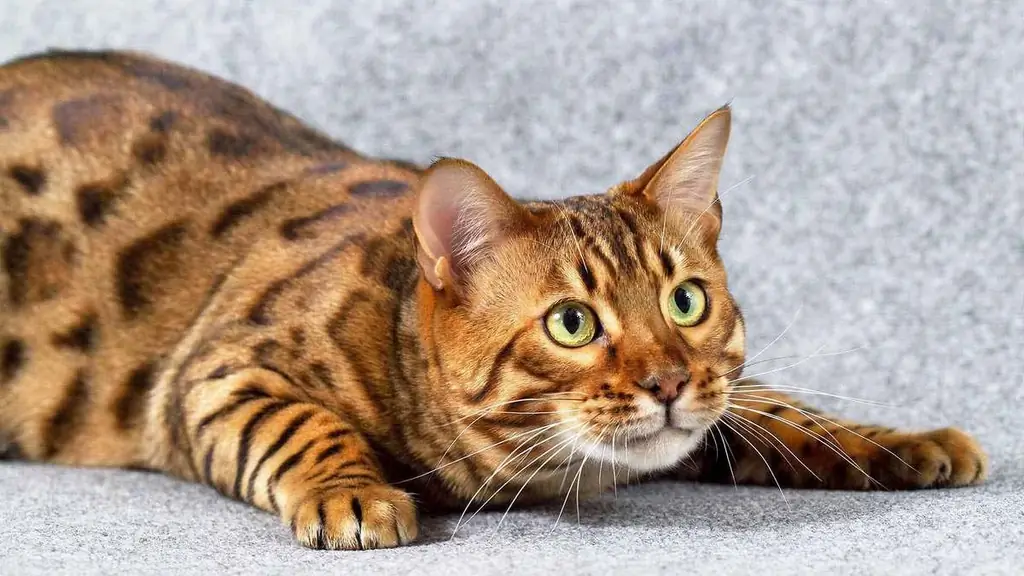
The origin of Bengal cats. External description of the breed. Features of the acquisition. The character and behavior of Bengals. The specifics of caring for a Bengal cat. Reviews
Cartesian Cat Chartreuse: Breed Description, Character And Upbringing, Maintenance And Care, Photos, Owner Reviews
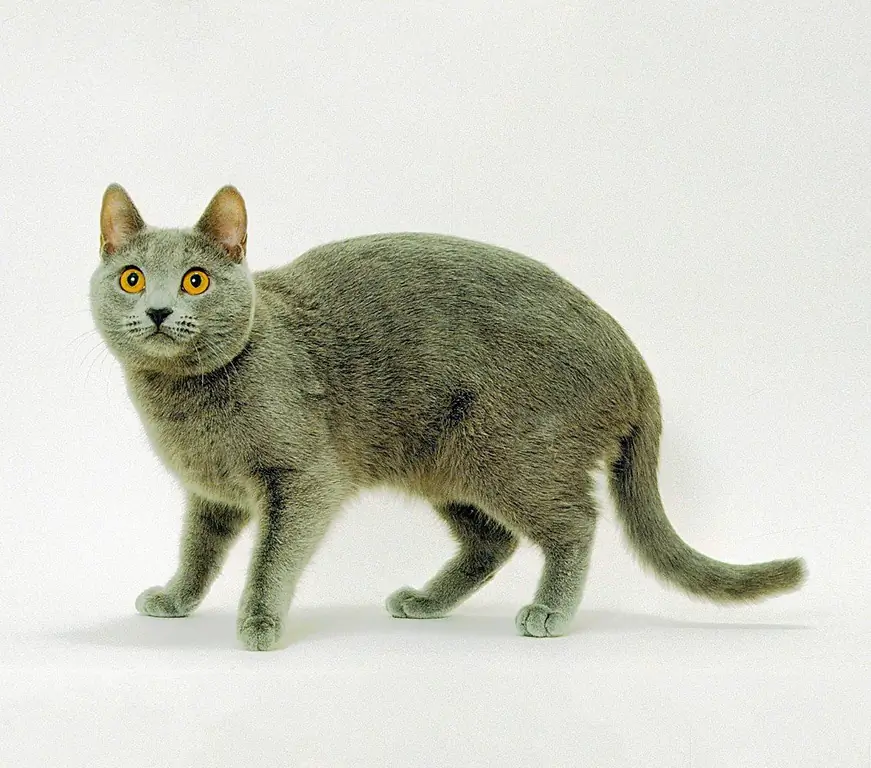
Where is the Chartreuse breed of cats bred, what are the main external differences, what character it has, how to properly care for the breed, how to choose a kitten
Serengeti: Description Of The Breed, Character And Habits Of The Cat, Care Features, Photos, Owner Reviews

History of origin, description of appearance, features of the breed. The character, behavior and health of the serengeti. Care and maintenance tips
Anatolian Cat: Features Of The Breed's Appearance, Care And Maintenance Of The Cat, Character And Habits, Breeding Pets, Owner Reviews
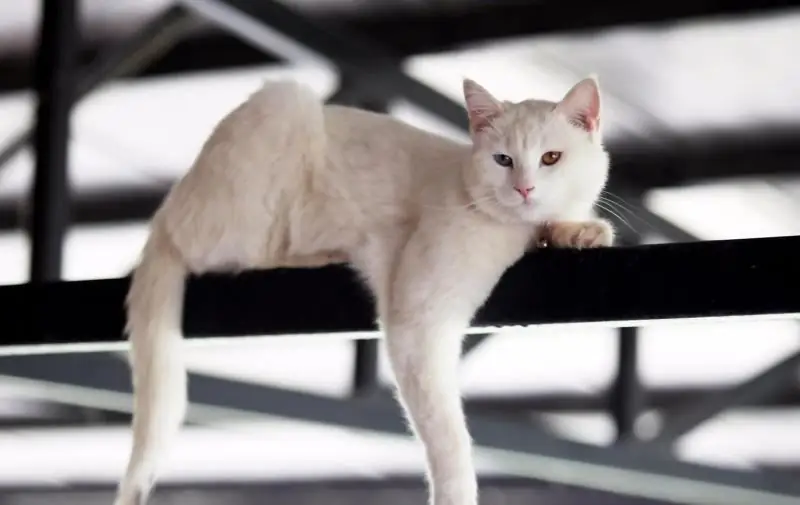
Where the Anatolian breed is bred. The main external differences, the nature of the pet. How to properly care for him, feed him. How to choose a kitten. Breeding. Reviews
Cornish Rex: Description Of The Breed With Photos, Character And Habits, Care And Maintenance, Reviews Of Cat Owners
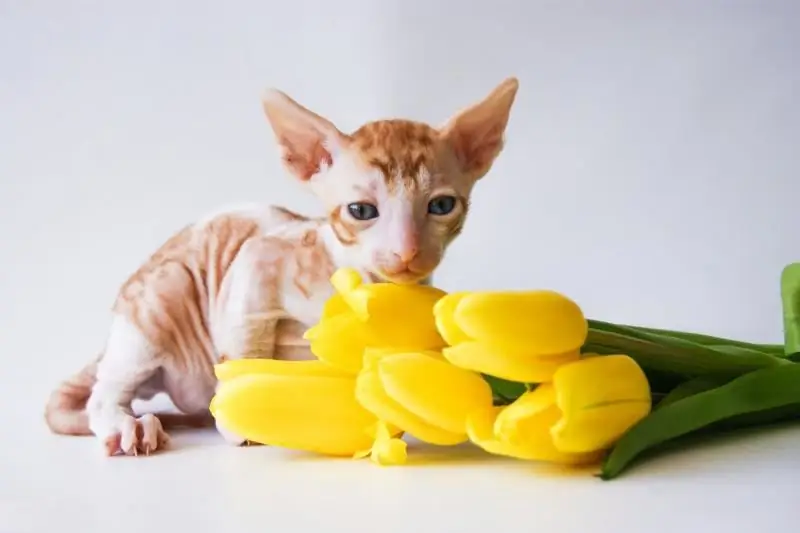
The history of the origin of the breed. What does a Cornish Rex look like? The nature of the cat. Care rules. What to feed the Cornish Rex. Reviews, photos and videos about the breed
